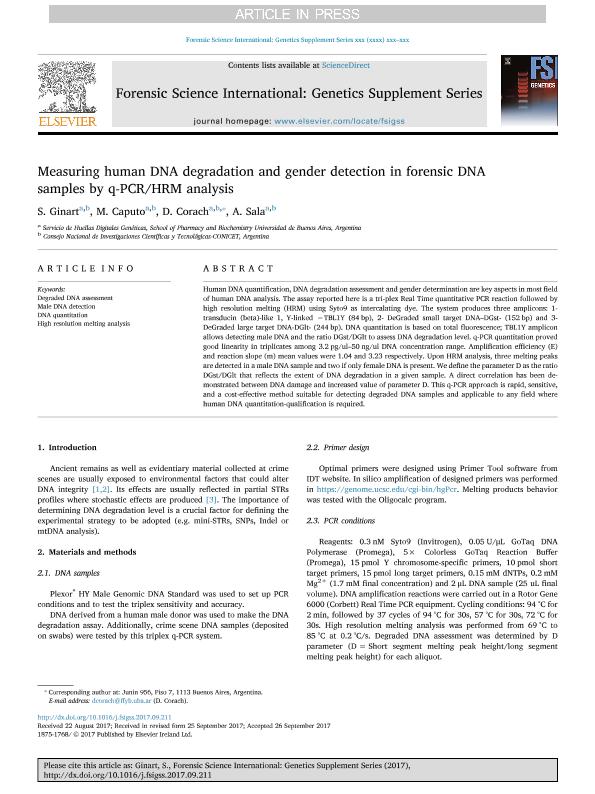Artículo
Measuring human DNA degradation and gender detection in forensic DNA samples by q-PCR/HRM analysis
Fecha de publicación:
12/2017
Editorial:
Elsevier Science
Revista:
Forensic Science International: Genetics Supplement Series
ISSN:
1875-175X
Idioma:
Inglés
Tipo de recurso:
Artículo publicado
Clasificación temática:
Resumen
Human DNA quantification, DNA degradation assessment and gender determination are key aspects in most field of human DNA analysis. The assay reported here is a tri-plex Real Time quantitative PCR reaction followed by high resolution melting (HRM) using Syto9 as intercalating dye. The system produces three amplicons: 1- transducin (beta)-like 1, Y-linked −TBL1Y (84 bp), 2- DeGraded small target DNA–DGst- (152 bp) and 3-DeGraded large target DNA-DGlt- (244 bp). DNA quantitation is based on total fluorescence; TBL1Y amplicon allows detecting male DNA and the ratio DGst/DGlt to assess DNA degradation level. q-PCR quantitation proved good linearity in triplicates among 3.2 pg/ul–50 ng/ul DNA concentration range. Amplification efficiency (E) and reaction slope (m) mean values were 1.04 and 3.23 respectively. Upon HRM analysis, three melting peaks are detected in a male DNA sample and two if only female DNA is present. We define the parameter D as the ratio DGst/DGlt that reflects the extent of DNA degradation in a given sample. A direct correlation has been demonstrated between DNA damage and increased value of parameter D. This q-PCR approach is rapid, sensitive, and a cost-effective method suitable for detecting degraded DNA samples and applicable to any field where human DNA quantitation-qualification is required.
Archivos asociados
Licencia
Identificadores
Colecciones
Articulos(OCA HOUSSAY)
Articulos de OFICINA DE COORDINACION ADMINISTRATIVA HOUSSAY
Articulos de OFICINA DE COORDINACION ADMINISTRATIVA HOUSSAY
Citación
Ginart, Santiago; Caputo, Mariela; Corach, Daniel; Sala, Adriana Andrea; Measuring human DNA degradation and gender detection in forensic DNA samples by q-PCR/HRM analysis; Elsevier Science; Forensic Science International: Genetics Supplement Series; 6; 12-2017; e552-e554
Compartir
Altmétricas




